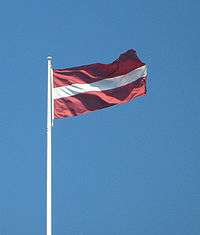Cultural regions of Latvia
Cultural regions of Latvia are several areas within Latvia formally recognised as distinct from the rest of the country. While some of these regions are seen purely as culturally distinct, others have historically been parts of different countries and have been used to divide the country for administrative and other purposes. The Constitution of Latvia recognises four distinct regions: Kurzeme, Zemgale, Latgale and Vidzeme.[1]
Regions
- Courland (Latvian: Kurzeme, Livonian: Kurāmō), the westernmost part of Latvia, consisting of the cities of Liepāja and Ventspils and the municipalities of Aizpute, Alsunga, Brocēni, Dundaga, Durbe, Grobiņa, Kandava, Kuldīga, Nīca, Pāvilosta, Priekule, Roja, Rucava, Saldus, Skrunda, Talsi, Vaiņode and Ventspils.
- Semigallia (Latvian: Zemgale) is the central part of Latvia. Zemgale is bounded by Kurzeme in the west, the Gulf of Riga, the Daugava river and Vidzeme in the north, Selonia in the east and the Lithuanian border in the south. It consists of the city of Jelgava and the municipalities of Auce, Baldone, Bauska, Dobele, Engure, Iecava, Jaunpils, Jelgava, Ozolnieki, Rundāle, Tērvete, Tukums and Vecumnieki. Traditional Semigallia also includes the northern part of Šiauliai County in Lithuania.
- Selonia (Latvian: Sēlija, Augšzeme) is often considered a part of Semigallia. Selonia comprises the eastern part of the 1939 province of Semigallia, roughly corresponding to parts of the former Aizkraukle, Daugavpils and Jēkabpils districts south of Daugava river. Traditional Selonia also includes a portion of north east Lithuania. Named after the Selonians.
- Vidzeme (Livonian: Vidūmō), meaning "Middle land", is also known as Livland, though it comprises only a small part of traditional Livland. Present Vidzeme is the Latvian part of Swedish Livonia and City of Riga. It roughly corresponds to the former Alūksne, Cēsis, Gulbene, Limbaži, Madona, Valka, Valmiera districts and parts of Aizkraukle, Ogre and Riga districts north of Daugava river.
- Latgallia (Latvian: Latgale, Latgalian: Latgola), the part of Livonia still in hands of the Polish-Lithuanian Commonwealth after the Treaty of Altmark in 1629, so called Inflanty Voivodeship. It roughly corresponds to Balvi, Krāslava, Ludza, Preiļi, Rēzekne districts and parts of Daugavpils and Jēkabpils districts north of Daugava river.
In some cases, Kurzeme and Zemgale are combined into one region. This reflects the political division of Latvia between 1629 and 1917, when Kurzeme and Zemgale were together, first as the Duchy of Courland, then as the Courland Governorate in the Russian Empire while Vidzeme and Latgale were politically separate, both from Courland and one from another.
From this perspective, there are three regions: Kurzeme (including Zemgale and Sēlija), Vidzeme and Latgale. Such division is no longer commonly used but it can be seen in the coat of arms of Latvia and the Monument of Freedom in Riga both of which contain three stars: for Kurzeme, Vidzeme and Latgale, which were united into Latvia in 1918.
See also
References
- ↑ Valts Kalnins (October 2001). "Elections". Latvian Institute of International Affairs (LIIA). Retrieved 2010-01-04.
